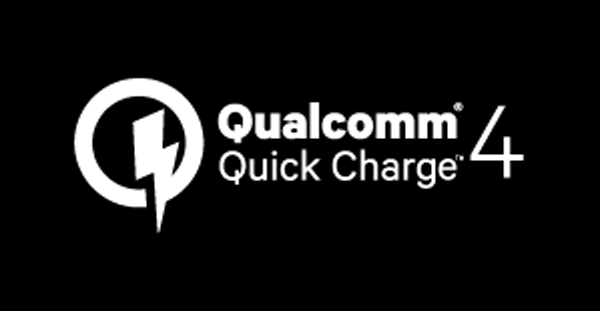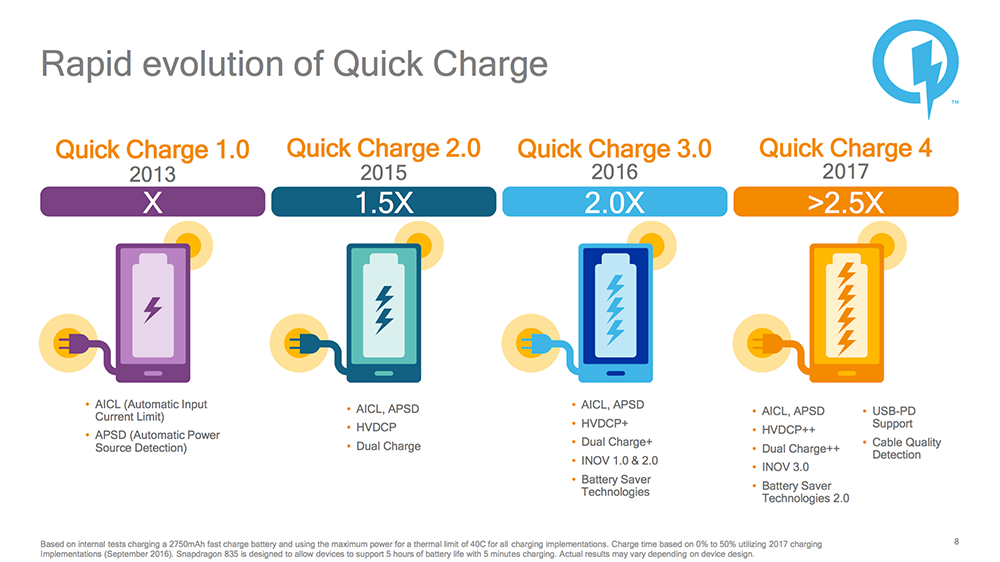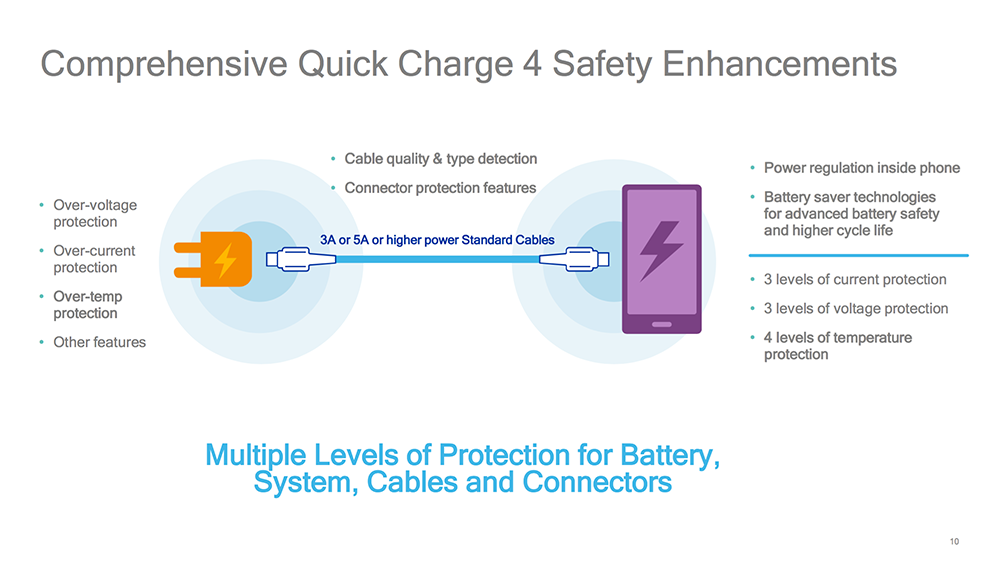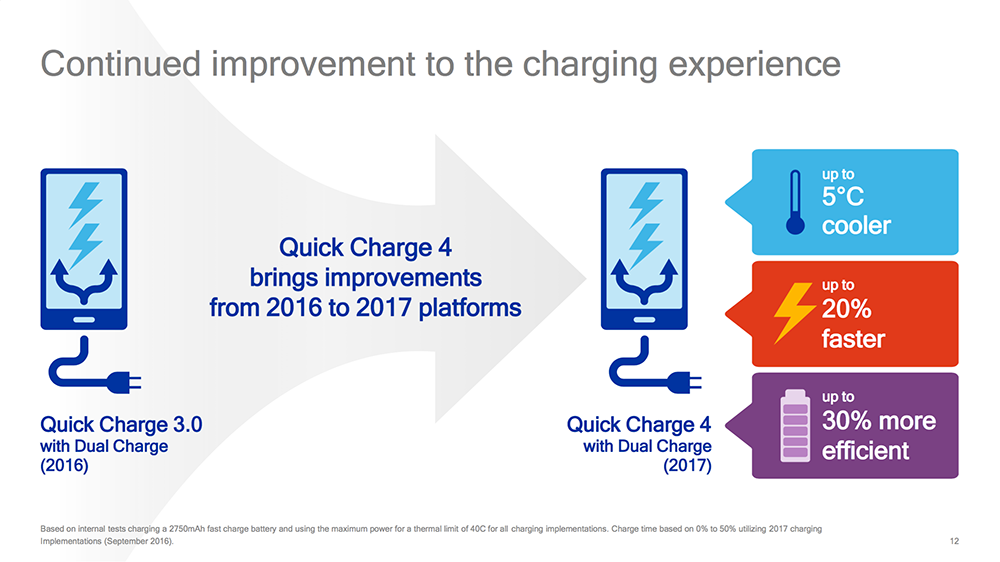Qualcomm Announces Quick Charge 4: Supports USB Type-C Power Delivery
by Matt Humrick on November 17, 2016 7:31 AM EST- Posted in
- Smartphones
- Snapdragon
- Qualcomm
- Mobile

Qualcomm did more than reveal the name of its next SoC, the Snapdragon 835, today at its Snapdragon Technology Summit in New York. It also announced an update to its fast-charging technology. Qualcomm’s Quick Charge 4 promises up to 20% faster charging and 30% higher efficiency than the previous generation Quick Charge 3 found in many current flagship phones.
This latest generation brings a number of improvements, but perhaps the most remarkable change is that Quick Charge 4 is now compatible with the USB Type-C and USB Power Delivery (USB-PD) specifications set by the USB-IF standards body. Previous implementations of Qualcomm’s proprietary charging technology alter the voltage delivered over Vbus to increase the charging rate, which violates the Type-C specification for standard charging that only allows for changing the charging current. They also use a different method for negotiating the charging parameters using the USB data lines that runs afoul of the Type-C specifications too. Quick Charge 4 addresses these issues and should satisfy the language Google recently added to its Android 7 Compatibility Definition Document (CDD) recommending device OEMs not use proprietary charging methods that are not compatible with USB-PD.
Quick Charge 4 also uses an updated version of Qualcomm’s INOV (Intelligent Negotiation for Optimum Voltage) power-management algorithm that now includes real-time thermal management to help optimize power transfer. It also uses an updated version of its Battery Saver Technologies that uses stepwise charging to help the battery maintain at least 80% of its original charge capacity after 500 charge cycles.
Battery health and charging safety are fresh on everyone’s minds after the battery fires that plagued Samsung’s Galaxy Note7. It’s only natural then that Qualcomm made safety a point of emphasis during its presentation. Quick Charge 4 incorporates over-voltage, over-current, and four levels of over-temperature protection, including chassis, battery, and PMIC temperature sensing. It can also sense the type and quality of the charging cable and adds additional protection from over-charging. Qualcomm says that protection “is implemented at multiple levels and throughout the entire charging process to more accurately measure voltage, current, and temperature while protecting the battery, system, cables and connectors.”
Qualcomm’s Quick Charge 4 will be available on devices using the Snapdragon 835 SoC and its two new power managements ICs (PMICs), the SMB1380 and SMB1381. The two PMICs work in tandem as part of the Dual Charge++ feature for improving efficiency, reaching 95% peak efficiency at 3A. The PMICs will be available by the end of 2016 and will be integrated into devices shipping in the first half of 2017.













28 Comments
View All Comments
pokemanengineer - Thursday, November 17, 2016 - link
Just use a charger that has lower current output. Can charge as slow as you want.prateekprakash - Thursday, November 17, 2016 - link
Is it possible to make a phone with dual smaller batteries that can be charged with dual charging ports?That would reduce the time required to charge a single battery with higher capacity which consume higher current in my opinion...
HomeworldFound - Thursday, November 17, 2016 - link
Double the amount of battery connectors and more ports? I don't think they'll want that.Mavendependency - Thursday, November 17, 2016 - link
It's a configuration that has worked well, try looking up laptop batteries.tygrus - Saturday, April 15, 2017 - link
I don't think people want to carry around two chargers to plug in. Please remember that the maximum charge current is proportional to cell mAH capacity, internal resistance and the ability to keep cool. The quick charge methods focus on increasing the charge rate while the temperature and internal resistance is lower and then reverting to standard charging for the last 20% of mAH.CharonPDX - Friday, November 18, 2016 - link
Wouldn't USB-PD on Type-C connectors make "Qualcomm Quick Charge" mostly irrelevant now? The big point of QC was that it can run higher than 5V over a USB connector, to allow higher Wattage power transfer at the same Amp rating. That's one of the core facets of USB-PD, too.Impulses - Friday, November 18, 2016 - link
Sure, that wouldn't be good for Qualcomm's licensing business bottom line tho... :p At least they're not flying in the face of the spec anymore.VivianLiu - Friday, December 2, 2016 - link
I like this one(https://www.amazon.com/dp/B01J5BO0RS), it is great for me.